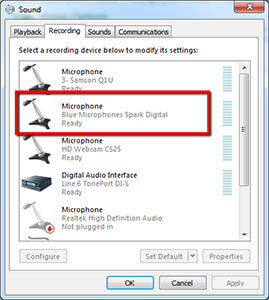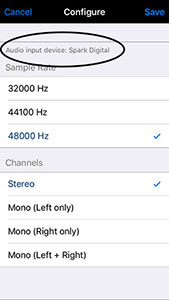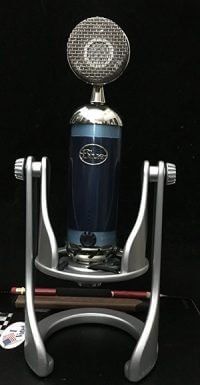My Review Of The Blue Spark Digital USB And iOS Microphone
I just had a chance to review the Blue Spark Digital USB microphone, which is not only a standard USB mic, but also works with your iPad or iPhone (as long as they are of a generation that uses the lightning cable connection).
The Blue Spark Digital is a large diaphragm condenser type mic. That makes it a good choice for such things as vocals and acoustic guitars, among other things.
The mic has a multi-function knob on the front which allows you to control BOTH the headphone volume from the mic (yes, you can monitor the audio from the mic itself with the headphone jack that is a part of the mic cable), AND the input level of your audio*.
By default, the LED lights are blue, which indicate the knob controls headphone volume. But if you press down and hold the knob for 3 seconds, the lights turn red, meaning that the knob now controls input level. This knob has a third function as well. If you press down briefly on the knob, it acts as a mute button. Pressing it again un-mutes it.
USB Mic Gain Controls In General
* When using USB mics with gain control knobs on the front, it is REALLY easy (too easy) to have the gain up too loud and end up with distorted sound. It isn’t as bad when recording, since you have visual clues in the recording software (like the meter going into the red).
But I’ve heard way too many distorted voices come through on web conferences, Skype calls, and webinars where folks are not given immediate feedback on whether their audio is distorting or not. In those non-recording cases, it is vital that you check the audio testing tool usually available in Skype, Google Hangouts, GoToWebinar, etc. Okay, back to our regularly scheduled review:).
Overall Impressions
The Spark Digital is an attractive and interesting looking mic. Its unusual shape is consistent with other microphones in the Blue lineup, such as the Bottle tube, and Baby Bottle and Bluebird mics. The Spark Digital comes with a desk stand that includes a shock mount, which is great.
But unlike the standard Blue Spark mic (NOT a USB microphone), the Spark Digital does NOT come with a pop filter, which is odd because this mic simply cannot be used for vocals without pop filter, since it is extremely sensitive to plosives and generates impressive (in a bad way) p-pops without a filter/screen to help prevent them.
So if you plan to use this mic for vocals you’ll need to buy a pop filter separately. You can use a standard filter attached to a separate mic stand, which is what I did for the review (a bit unwieldy), or you can get the pop filter designed for Blue mics – “Blue The Pop Universal Wire Mesh Windscreen.”
Hard to Use On A Desk
Something else that I don’t like about most USB mics is that they are designed to sit on a desk, which is fine for some folks. But this seriously limits flexibility when using the mic.
Lots of people (that may or may not include me:-P) like to put their mics on a standard mic stand so they can stand up while recording or place the mic at any height and any angle, especially useful when recording instruments.
There is an adapter for the Blue Spark though, that will work with the Spark Digital as well. But you also have to buy it separately. There used to be one specifically for the Blue Spark. But now they have one that will fit multiple of their mics here.
Without that mic stand mount, you’ll be stuck with the desk stand that comes with the Spark digital, which is unique in shape and function. But it’s really awkward to handle and I had a super hard time trying to get the mic screwed into the mount. That was really frustrating. If I were going to use this mic in my studio full time, I would absolutely purchase the extra mic stand mount and pop filter.
The Tests
I did several recordings with the Spark Digital, using USB and an iPhone 6S. The mic has two modes – Normal mode and Focus mode. Blue describes Focus mode as enhancing “clarity and detail.” There is a tiny black switch on the back of the mic for toggling between these two modes. Another of my quibbles with the mic was that the rubber cap to this switch popped off after only the 2nd time I switched it. But it was easy enough to pop back on. Anyway….
How Does It Sound?

The real test of a mic is how it sounds. And this one sounds pretty darned good. The mic comes with two cables – one for a standard USB connection to a computer, and the other has a lightning connector for use with iPads or iPhones.
To test the USB capability I plugged the mic into my windows 7 machine. Windows recognized it immediately, so the plug-and-play works well. See figure 2. Even with the gain knob on the mic turned all the way down, the mic was still too loud for recording into Reaper (my audio recording program). I needed to lower the level in the Windows Audio Device screen to about 50%.
P-Pop-A-Looza
After that was taken care of, I recorded the first pass of some spoken voice-over type stuff with NO pop filter. I expected the p-pops to be bad, but wow were they loud – so loud, in fact that even with recording levels super low, the p-pops were so loud that they clipped/distorted. Below is that audio. [note: P-pops were NOT edited in any way, which is why in some cases, the volume may seem low on the voice where no plosives appear (because the p-pop itself was so loud that it exceeded input limits)].
I recommend using headphones when listening to the below audio, in order to hear the subtle details.
Windows 7 USB Recording No Pop Filter (normal mode)
https://s3.amazonaws.com/HBAAudios/Spark+Normal+Mode+No+Pop+Filter.wav
Windows 7 USB Recording No Pop Filter (Focus mode)
https://s3.amazonaws.com/HBAAudios/Spark+Focus+Mode+No+Pop+Filter.wav
Things got considerably better in the p-pop department when I used a standard pop-filter on a separate mic stand (since there is no way to attach one to the included desk stand):
Windows 7 USB Recording With Pop Filter (normal mode)
https://s3.amazonaws.com/HBAAudios/Spark+Normal+Mode+With+Pop+Filter.wav
Windows 7 USB Recording With Pop Filter (Focus mode)
https://s3.amazonaws.com/HBAAudios/Spark+Focus+Mode+with+Pop+Filter.wav
Next, I wanted to compare the audio quality with another USB mic, one that costs a lot less at $45, the Samson Q1U. Here is what that sounded like. Can you tell the difference? Of course the Samson does not work with iOS:).
Samson Q1U – No Pop Filter
https://s3.amazonaws.com/HBAAudios/Samson+Q1U+no+pop+filter.wav
Samson Q1U – With Pop Filter
https://s3.amazonaws.com/HBAAudios/Samson+Q1U+with+pop+filter.wav
Next it was time to do the iOS tests. I used the iPhone 6S. The Spark Digital is recognized by most iOS recording apps (Garage Band, Cubasis, Auria, Rode Rec, etc.). I used the Rode Rec app, which immediately recognized the Spark Digital once plugged in via the lightning connector. See Figure 3.
The iOS Audio Results (everything will have a pop filter from now on)
Spark Digital Through iPhone 6S in Normal Mode
https://s3.amazonaws.com/HBAAudios/Spark+Digital+iPhone+Normal+Mode.wav
Spark Digital Through iPhone 6S in Focus Mode
https://s3.amazonaws.com/HBAAudios/Spark+Digital+iPhone+Focus+Mode.wav
Finally, I thought it would be a good comparison to hear what the same voice-over would sound like recorded directly into the iPhone, using its own internal microphone.
Just the iPhone
https://s3.amazonaws.com/HBAAudios/Just+iPhone+For+Spark+Review.wav

In my opinion, the “iPhone only” (using just the iPhone mic and not the Spark) recording was pretty bad when compared to the Spark Digital through the iPhone.
This is great news for anyone wanting to record pro audio with just an iPhone or iPad. That allows you to record on-the-go without hefting power supplies, external audio interface boxes and a laptop computer with you.
In Summary
At the heart of it, this mic is definitely worth its nearly $170 cost, if for no other reason than it works so well with an iPad or iPhone in addition to being a good quality USB mic. Personally, I thought the sound quality was very good – in the realm of :pro quality” audio. I especially like that the noise level – the hiss usually apparent in USB mics seemed lower than most other USB mics.
I really didn’t notice much of a difference between the Normal and Focus modes. Your mileage may vary.
I did have a few quibbles, which were primarily logistical and had little-or-nothing to do with the audio quality. And you’re DEFINITELY going to want a pop filter for vocals. But otherwise I think you’ll be quite happy with the sound you can get with the Spark Digital.
I don’t think it will replace my Rode NT2-A or my new EV RE20, but then both of those mics require an investment of close to $500 each, whereas the Spark Digital is only $170 (which could go up to about $300 if you buy the mount and pop filter). So the comparison isn’t really fair.
Overall, this mic sounds really good, and would be perfect for anyone who needs to be on the go and record with their iPad or iPhone as well as a laptop.
CLICK HERE to find out more or to buy one of your own.
If you’re interested in more details, including the technical specs and some of the specific models of iOS products supported, etc. CLICK HERE to go to the Blue site.


I just purchased this mic from a pawn shop and they said it didn’t come with a cord and I paid 200 for it and have been looking for a cord for two weeks please help.
Is it a standard mic with 3 pins on the bottom?
Hello there.
I’ve been a long user of the Blue Spark Digital since 2016. Sonically, one of the best USB mics on the market. Now it is discontinued. It was ready even for such old op systems like Win XP. I share your concern about the “logistical issues” since nowadays it is really hard to find any replacement parts for the microphone (USB or lightning cables, rubber bands for the elastic suspension, etc). I haven’t been able yet to figure out which type of USB connector lies in the bottom of the microphone.
If you know such information, it would really be appreciated to receive that comment.
Thanks for your review.
Hi Javier. I don’t have any additional information on the mic since I did not keep it. I’m recommending that if people have it in their budget, they should try to use a standard mic with an interface, rather than a USB mic. the quality is pretty much better across the board.
A painless setup routine goes a long way in making the Spark Digital a pleasure to use. The fact that it s iOS-compatible and that it takes up less space than the Yeti makes it more likely you ll take it on the road for capturing a new instrumental or doing some podcasting from a hotel room (a likely use case for Engadget editors, anyway). Thanks to the built-in mute control, we never had to worry about keystrokes, coughs or other noises creeping in mid-broadcast while we weren t speaking. The Spark Digital did pick up a bit of room noise while we were recording acoustic guitars, but it s nothing that can t be cured in postproduction.